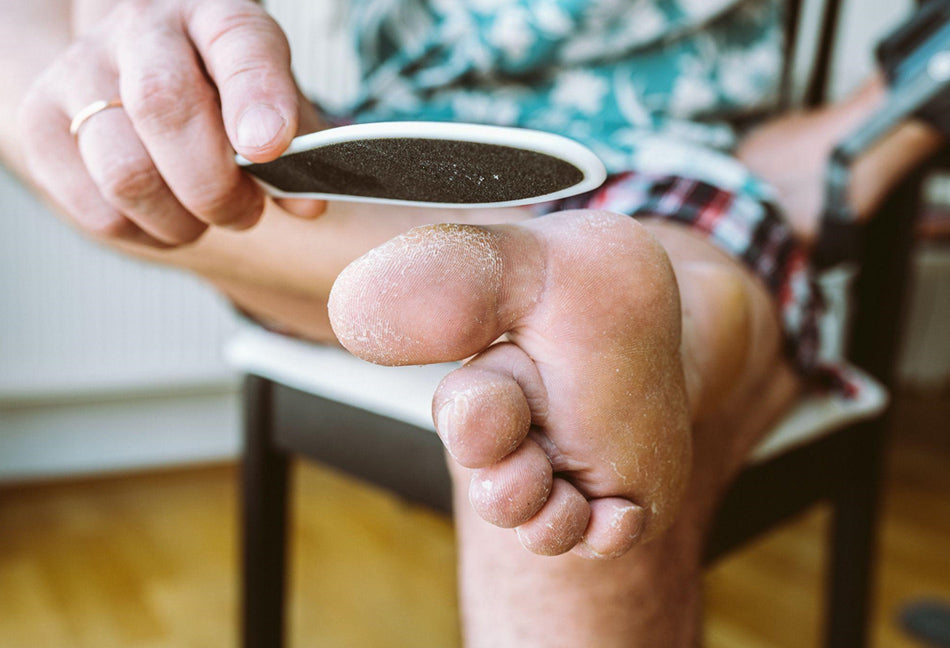Corns and calluses can be painful or uncomfortable and may have a significant impact on your day-to-day activities, but that doesn’t necessarily mean they require urgent treatment from a medical professional. Below, we outline the various treatment options available, and make it clear when you should see a doctor or podiatrist about your symptoms.
How to get rid of corns on feet
Prevention is the best kind of cure, and it can be helpful to understand the causes of corns in order to try to avoid developing one yourself. But if you already have a corn, you’ll need strategies to reduce the discomfort of the symptoms and get rid of the condition safely.
There are two levels of treatment options available. For the majority of cases, at home treatments will be sufficient to get rid of your corn or callus. These are usually non-invasive and easy to do yourself or with the help of a loved one. If you’ve tried at home treatments and the situation persists, however, you may need the assistance of a healthcare professional for stronger or more targeted treatments.
Important! You shouldn’t try to treat corns or calluses yourself if you have one of the following conditions:
- Circulatory problems
- Heart problems
- Diabetes
Foot problems can be more serious with these conditions. Speak to your GP or a podiatrist if you have a corn or callus in these circumstances.
How to treat corns
As mentioned earlier, many corns and calluses aren’t serious and should go away with treatment at home. The biggest contributing factor to corns and calluses developing is pressure, so the key to both preventing and treating them is to reduce pressure.
If you have a corn currently, it has probably formed on a part of your foot that is often under a lot of pressure. You’ll want to spread that pressure more evenly across your foot, so consider trying a pressure-relieving insole designed to do just that. Insoles that allow you to pop out small sections make it easier for you to reduce pressure on any given point on your sole while safely spreading the pressure elsewhere.
Additionally, why not try techniques to supplement the use of insoles? These can include things like wearing thicker socks and cushioned shoes to reduce pressure on your feet. Don’t wear shoes that have high heels or pointed toe boxes – these can often lead to friction and increased pressure on the feet. It’s also not the best idea to go barefoot, as there is little to cushion your feet.
Where possible, give your feet as much time as possible to rest. That means avoiding walking or standing for long periods of time. If you need to do so for your job, consider asking for temporary accommodations to help your feet recover – and make sure you’re wearing thick socks and comfortable shoes as outlined above to protect your feet as much as you can.
You can also adapt your current footcare routine to treat your corn. Firstly, soak your feet in warm water to soften the skin of the corns or calluses. Then use a foot file or pumice stone to reduce the hardened skin. Do this regularly to avoid it building up. Finally, finish your footcare routine off with a urea foot cream to encourage healthy, softer skin.
Although it might seem quicker and easier than filing hard skin, you should never try to cut a corn or callus off your own foot. This can easily lead to infections that can have serious complications, and any cuts or wounds could be more painful and impactful than the original issue.
How to remove corns
If the discomfort from your corn or callus hasn’t improved after three weeks of treatment at home, it’s time to see a doctor or podiatrist about the problem. It’s uncommon for additional treatment to be needed, but if it is, your doctor should be able to help you get what you need. You should also seek medical attention if:
- You have heart problems, diabetes or circulatory issues
- The corn is causing such pain it prevents you from sleeping or walking as normal
- The corn bleeds or leaks any pus or discharge
If you visit your GP, they may be able to help with issues such as infections or other conditions that might be making your corn or callus worse. A bacterial infection might require a course of antibiotics to treat, for instance – and your doctor can give you more advice on how to treat the corn at home if needed.
You might alternatively be referred to a podiatrist – a healthcare practitioner who specialises in treating foot conditions. They may be able to offer specialist treatments to soften the skin or relieve pressure on the affected area. If other treatments don’t work, they might cut away the corn or callus in controlled conditions. It’s very important that you don’t try to do this yourself, and that you follow any instructions your podiatrist offers with regards to aftercare.

